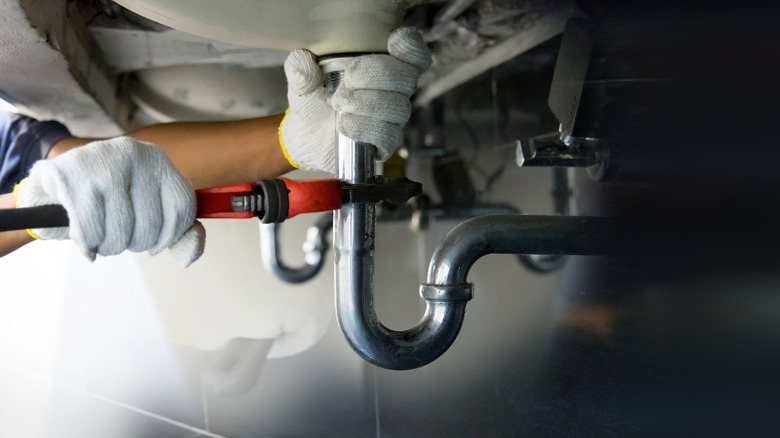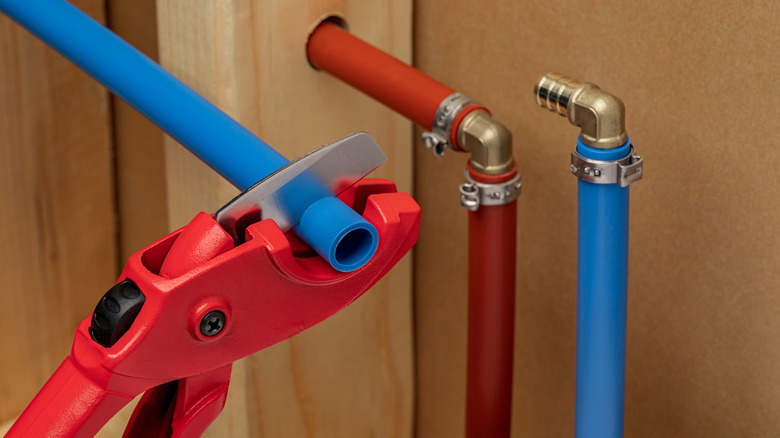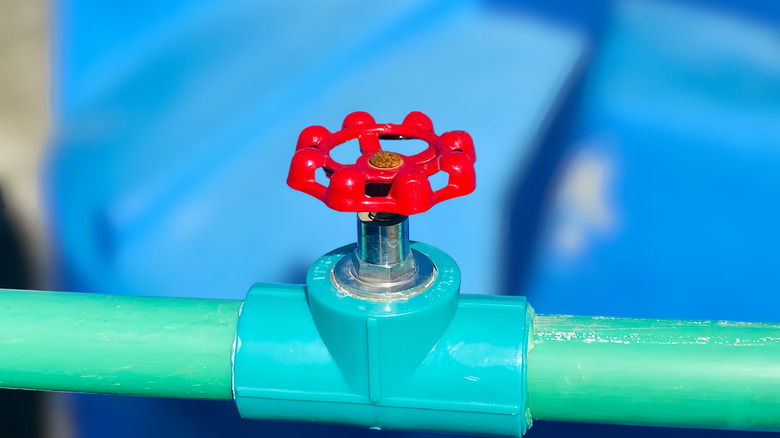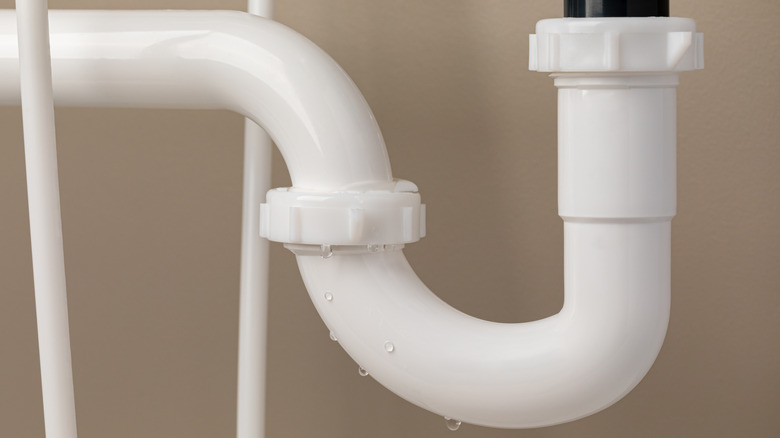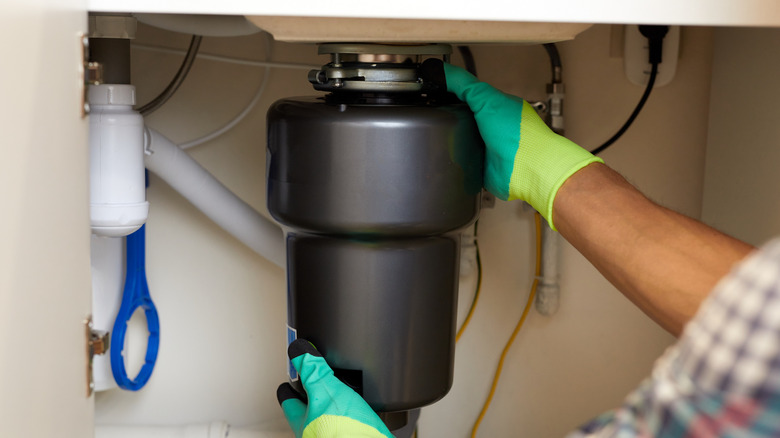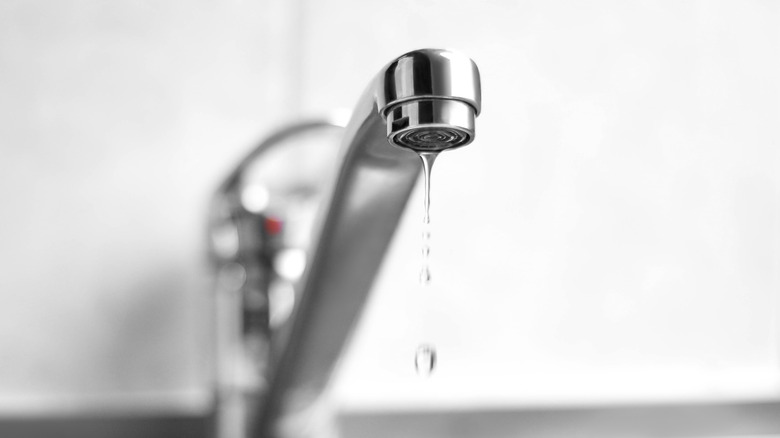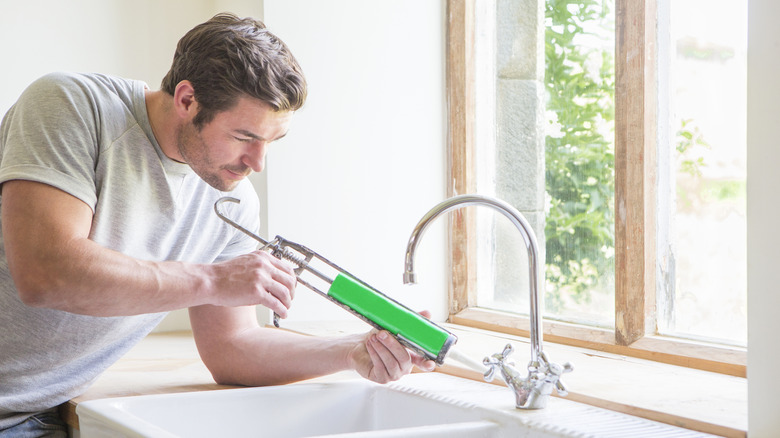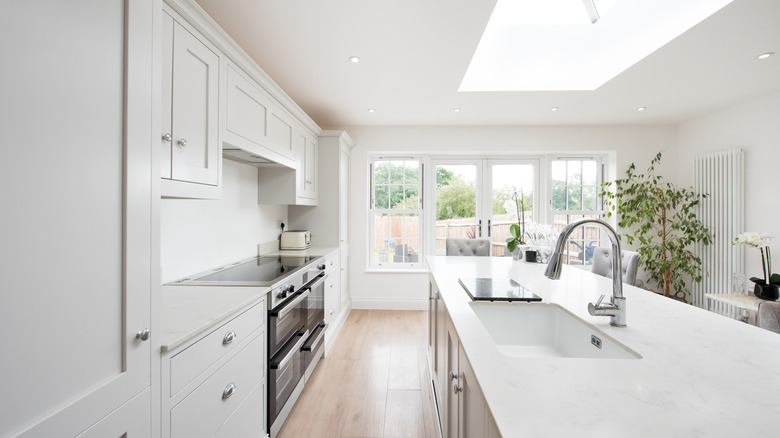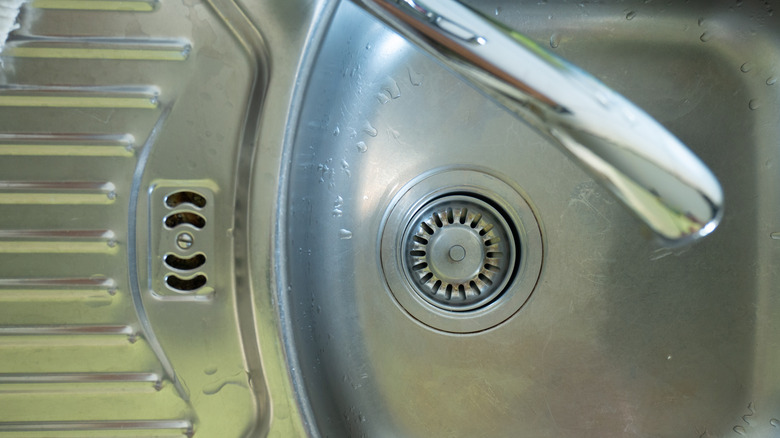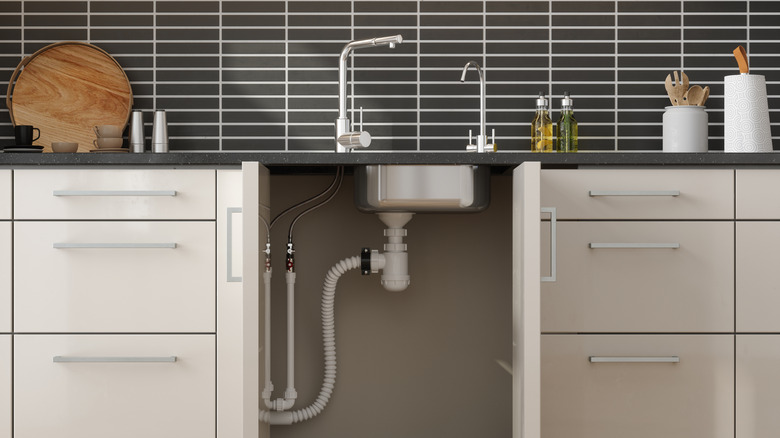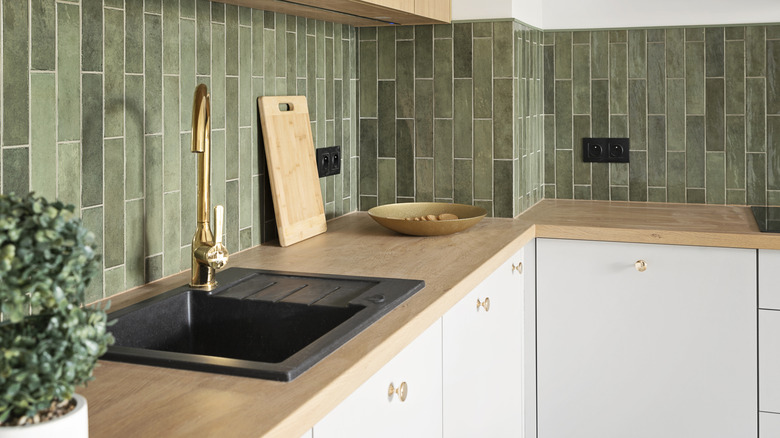10 Reasons Your Kitchen Sink Is Leaking And How To Fix It
Your kitchen sink may be among the least glamorous spots in your home, but without question, it's one of the most essential. Even if you don't do a lot of cooking, it's there to fill your coffeepot in the morning and your bucket on cleaning day, as well as to clean off any fruit or salad fixings you may pack in your lunch for work. And, of course, it's there when you need to wash your dishes (or at least rinse them off before putting them in the dishwasher).
In short, the kitchen sink is an unsung workhorse in the kitchen. Most of us rarely give it a second thought unless something goes wrong — for instance, if the drain gets clogged or if the sink starts leaking. While clogs can be a pain, they're usually easy to diagnose and fix. Leaks, however, can be baffling and stressful. While some are easy to catch and quick to repair, others can go undetected for months, causing your water bill to skyrocket as well as mold and rot to take hold in hidden parts of your home. To help you find, understand, and stop kitchen sink leaks, we've enlisted a team of experienced plumbers: Aaron Adams, CEO Aaron Services; Joseph Wade, VP operations at Benjamin Franklin Plumbing; Peter deBaptiste, president of Joe Cole Plumbing, and Allyssa Estes, virtual plumbing expert for the household maintenance platform and app Frontdoor.
A faulty supply line can be the problem
If you've suddenly noticed suspicious puddles or wet spots under your kitchen sink, a likely culprit is a faulty supply line — that is, one of the lines that directs water into your faucet. To determine if this is the case, thoroughly dry everything under your sink — the drain lines, pipes, and garbage disposal, if you have one — then get under there with a flashlight and take a look. You may see water start to appear on one of the lines — this is the source of your leak. If this doesn't work, try running the faucet for a few minutes to catch the leak in action.
If the supply line is the problem, you have no cause for panic. "It's often just a matter of tightening a connection," Peter deBaptiste said. And even if the line itself is on its last legs, replacing it is a straightforward matter. "A leaking supply line is also a fairly simple fix that some homeowners can do themselves," Aaron Adams said. "They'll just need to be sure to use the correct supply line replacement. This is best done by removing the supply line and bringing it with you to the store." Before you do this, Adams emphasized, be sure to turn off the water supply for the sink — or safer still, for your whole house — to prevent an unintended flood.
A broken stop valve may cause constant drips
Another likely cause of puddles or water spots under your kitchen sink is a broken stop valve — this is the valve that controls water flow to your sink. Other signs that the stop valve is in trouble are wetness on or around the valve itself, signs of corrosion on or around the valve, or reduced water pressure to your kitchen sink.
If you spot any of these, this means the stop valve needs to be repaired or replaced. This is a much more complex and risky process than replacing a supply line, so you should think twice before trying to handle it yourself. "This repair is more involved and should be handled by an experienced plumber. You can easily flood your home by improperly replacing a stop valve," Aaron Adams said. To avoid a hefty plumber's bill, Adams advises that you take steps to ensure the valve doesn't get damaged in the first place. "Be careful with what you store under your kitchen sink, as you don't want items being shoved against your supply lines and valves," he said.
A clogged sink can cause the p-trap to leak
You've almost certainly noticed that the drain pipe under every sink has a distinct shape. Connected to the vertical length of pipe directly attached to your drain is a U-shaped segment connected to a horizontal length of pipe leading into the back wall of your sink cabinet and away from the sink. This structure, called the p-trap, serves a number of purposes besides moving water out of the sink. Its unique shape enables water to flow out, but keeps wastewater from flowing back in, and it also keeps sewer gases such as methane from moving into your house through the drain.
But like other components in kitchen sinks, p-traps can be vulnerable to leaks. These leaks are often the result of faulty installation, but clogs can also trigger the problem. "We sometimes see leaking p-traps when a kitchen sink is clogged and backing up," Aaron Adams said. If you do spot a leak coming from the p-trap, your best move is to deal with it quickly, since minor leaks can escalate into serious problems faster than you think.
If your garbage disposal leaks, it needs to be replaced
For enthusiastic home cooks, a garbage disposal can be a godsend — it lets us send small trimmings and scraps from plates down the drain without a worry, thus speeding up post-meal clean-up operations. Unfortunately, however, it can also be the source of leaks under your kitchen sink, and these won't be fun to fix. While some leaks are the result of faulty connections between the disposal and drainage system that just need tightening, leaks from the disposal itself are bad news. "If your garbage disposal is leaking, it generally isn't reparable," Aaron Adams said.
To keep your garbage disposal from developing fatal leaks, treat it with respect. Remember, it's intended to help you get rid of stray bits of food, not replace your wood chipper. Don't use it to dispose of bones, seafood shells, or other hard materials. Also, keep fibrous foods, such as celery or corn cobs, out of the disposal — they can easily clog it. And of course, grease, as your mom told you, should never go down the drain. Keeping your disposal clean will also help it last longer — run water through it for several seconds after each use, and occasionally run an ice cube through it to clean the blade.
If your faucet is leaking, check the o-ring
Among the easiest leaks to spot is a dripping faucet — it's hard to walk past your kitchen sink without seeing or hearing it. And annoying as the drip may be, it'll most likely be easy to fix. "Most leaks from kitchen faucets are due to an old O-ring, which is a rubber ring inside the faucet that helps create a water-tight seal and prevents leaks," Joseph Wade explained. "To replace the old O-ring, you'll need to take apart the faucet and then put it back together, possibly even replacing some other old or corroded pieces."
If your faucet is fairly new and comes from a major manufacturer, you should be able to track down any other parts of your faucet that need to be replaced. "Delta, Price Pfister, and Moen are examples of reputable brands with good customer service support," Aaron Adams said. "They'll often offer troubleshooting over the phone, and if they can pinpoint the cause of your trouble and confirm the product is still under warranty, they'll often ship you the replacement part for free." If you're handy, you can take care of the repair yourself — otherwise, you can have a plumber install the replacement parts for you. But if there's serious rust or corrosion, a new faucet may be more cost-effective.
Corroded caulking can also cause leaks
If you've noticed moisture or mold under your sink but none of the drain lines or other components under the sink are leaking, the source of the problem may be hiding in plain sight. "Sometimes, if the caulking around the sink starts to fail, water can sneak under the rim and cause leaks below without it being obvious right away," Peter deBaptiste said. And this happens more often than you might think. "This is the most common leak I deal with," Eric Olson said.
These leaks are especially nefarious because they can be hard to detect — which means that slowly leaking water can do plenty of damage before you catch and stop the problem. "Over time, this can cause wood rot, mold, and rust," Olson said. The big takeaway here is that caulking around your kitchen sink isn't just for visual polish – it's essential for protection against leaks. Think about how much water gets splashed around the edges of your sink every day as you prepare meals and wash your dishes — then imagine that water seeping under your sink. Caulk wears out and cracks over time, so keep an eye on it — and do your best to keep the area around the edges of the sink dry.
Cracks in the sink itself can't be fixed
Leaks through cracks in the body of the sink itself are a less common but easily noticeable problem. While small hairline cracks, especially around the drain, are common in porcelain and stone sinks and not structurally problematic, cracks that grow big enough to allow leaking are a death sentence for your sink. "If water is leaking through a crack in the sink itself, that's usually game over. It's time for a new sink," Peter deBaptiste said. Aaron Adams agreed. "If a sink is cracked, you'll likely need to replace the whole sink," he said.
You can take steps, however, to avoid this problem, or at the very least, prevent small, merely unattractive cracks from becoming structural vulnerabilities. If you have a stainless steel sink, you're in luck — while they can develop problems just like other sinks, cracking isn't one of them. If you have a porcelain or stone sink, however, you can protect it by not subjecting it to rapid fluctuations in temperature — for instance, if you drain boiling pasta-cooking water down the sink (don't— there are better uses for it), then immediately dump in a bucket of ice, the thermal stress can result in cracks. In addition, harsh chemicals such as drain cleaners and some cleansers can also cause cracks, so use them only as a last resort, if at all. Instead, to keep your sink spotless, choose the right tool for the job.
Drain basket leaks are fairly simple to repair
A common factor connecting many kitchen sink leaks is they tend to happen at connection points, such as at the edges where the sink meets the counter or where supply lines are fitted to the sink or household water system. "It is important to realize that wherever there is a seam or joint, that area can and may eventually leak," Allyssa Estes said. Another such case is that of the drain basket, the small receptacle just inside the drain and above the drainpipe.
These leaks often don't result from problems with the drain basket itself, but from weakened connections between the drain basket and its neighboring components. So if you notice a drain basket leak but the basket itself looks fine, this should be a straightforward problem to correct. "If it's a leak from the drain basket, you can usually unscrew it, scrape off the old plumber's putty, and reseal it with fresh putty," Peter deBaptiste said. But in some cases, he added, drain baskets will require extra attention, "especially if the putty has dried out or the basket is corroded."
Here are some ways to detect hidden leaks
Kitchen sink leaks can sneak up on you, especially if they're slow leaks that occur under the sink. But even if you don't notice them, they can still cause major problems. "No homeowner should let leaks go unattended," Joseph Wade said. "Water damage leads to increased moisture in the air, resulting in mold growth that can potentially impact the health of those living there. Mold and mildew begin to grow after 24-48 hours of water exposure, which is why it's important to act fast and not let the leak get worse."
Even worse, Wade added, this moisture can attract pests such as cockroaches and termites into your home. Checking your sink regularly can help you catch problems before they escalate. "Check under your sink every few months. Look for signs of moisture, rust, or warped wood," Eric Olson said. Also, Wade advised, keep an eye out for suspiciously high water bills or suspiciously low water pressure -– both could indicate an undetected leak. And Allyssa Estes advised homeowners to monitor how their sink behaves. "Be aware of the performance of your fixtures and note any changes from what you are accustomed to," she said. "For example, a cartridge may need to be routinely replaced, and this routine maintenance activity will extend the life of the fixture."
These sinks are the least vulnerable to leaks
If your leaky kitchen sink is on its last legs, you'll want a replacement that won't cause the same problems to repeat themselves. Our experts offered some useful tips for what to look for in a new sink. "For a combination of durability, ease of cleaning, and aesthetics, stainless steel and granite composite are generally considered the best sink materials," Allyssa Estes said. "Stainless steel is highly durable, stain-resistant, and easy to clean, making it a practical choice for busy kitchens." Eric Olson offers another recommendation. "Overmount cast-iron sinks are among the most durable and least prone to leaks. Why? The sink lip sits above the countertop, so it doesn't rely solely on a silicone seal, and cast iron is heavy, stable, and long-lasting."
Also, Aaron Adams said, be mindful of whom you buy from. "You want to buy from a brand that stands behind its products. This is not the time to find a deal on the internet from an unfamiliar supplier," he said. "Along those lines, don't buy from the builder grade manufacturers at the big box stores, as it can be difficult to get support if there's a problem down the road." And once you've found the right sink, be picky about who installs it. "When selecting a new sink, to guard against future leaks, the type is less important than proper installation and regular maintenance," Estes said. "Whether you have a leak or not is a result of the installation and any loosening, wear, and tear over time."
